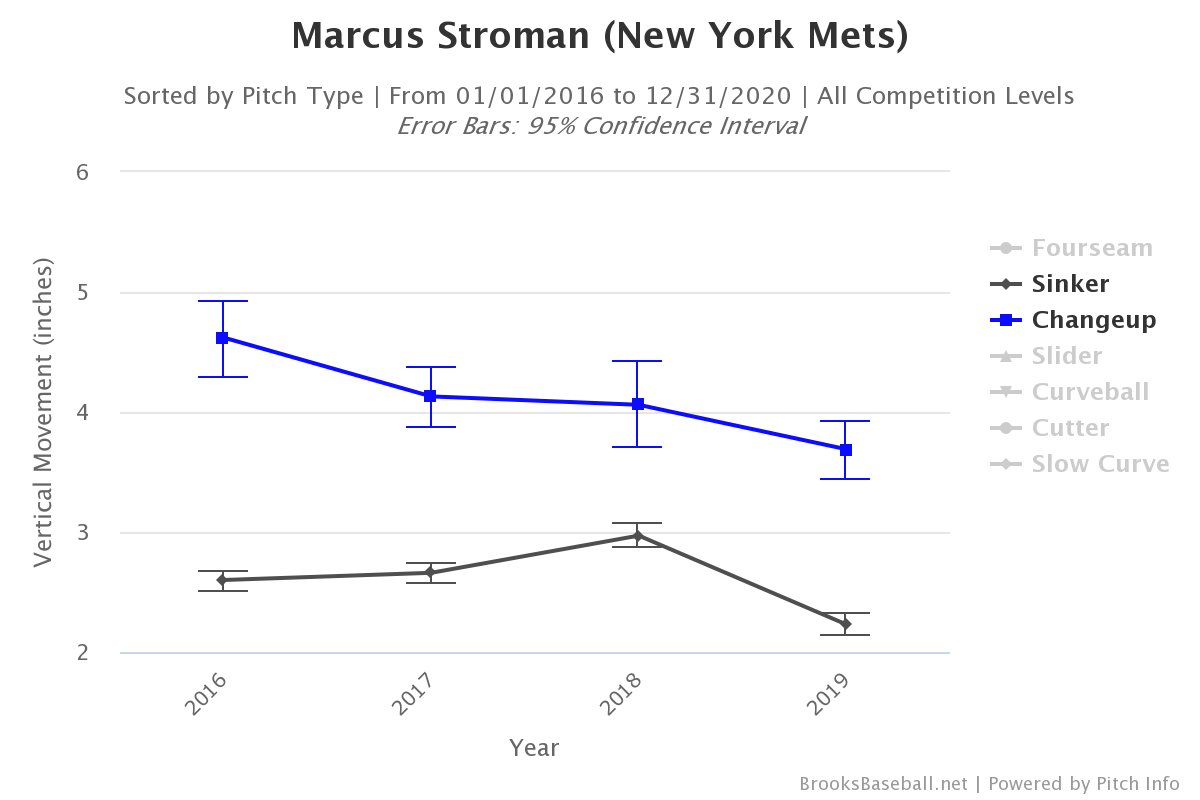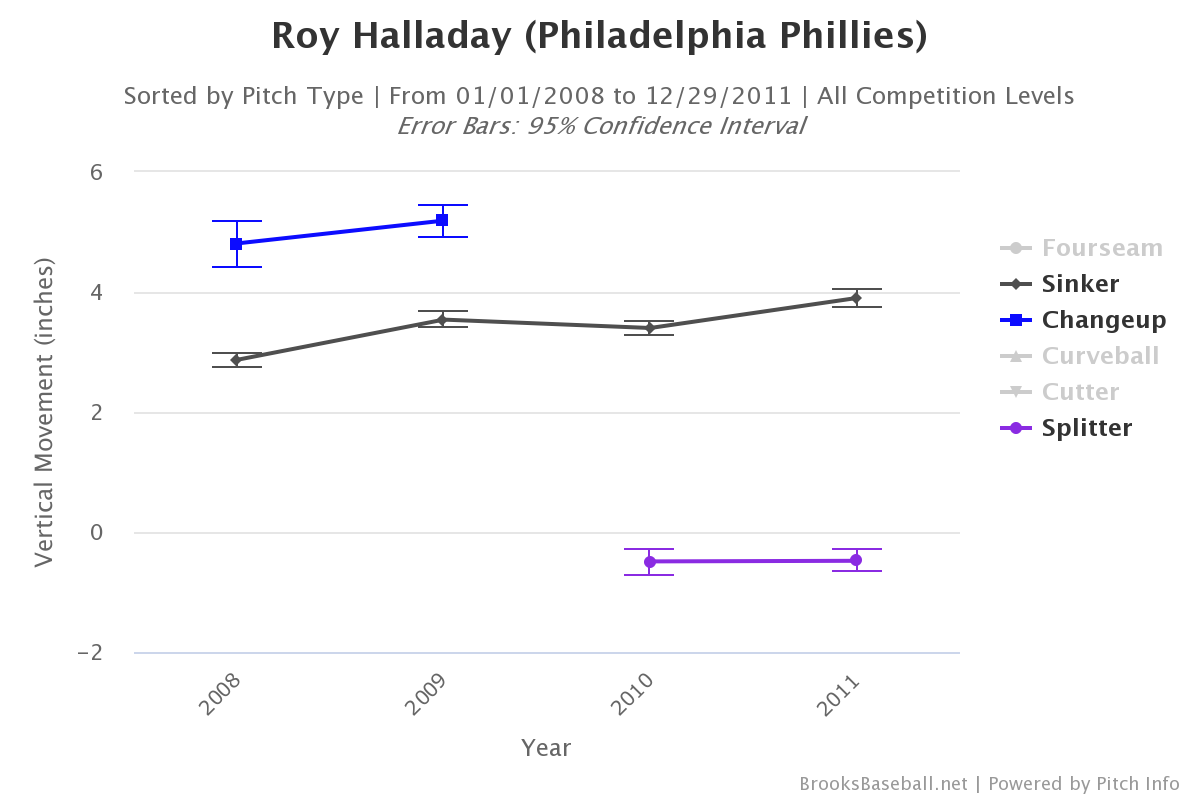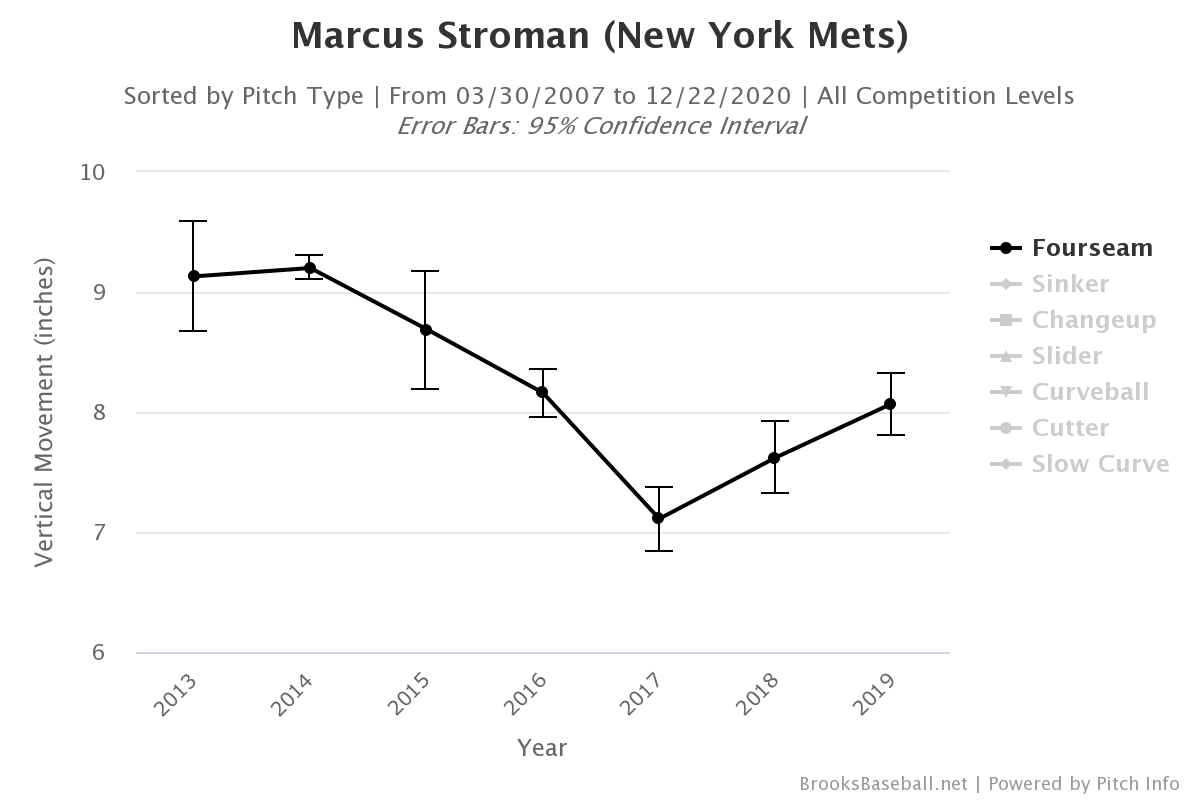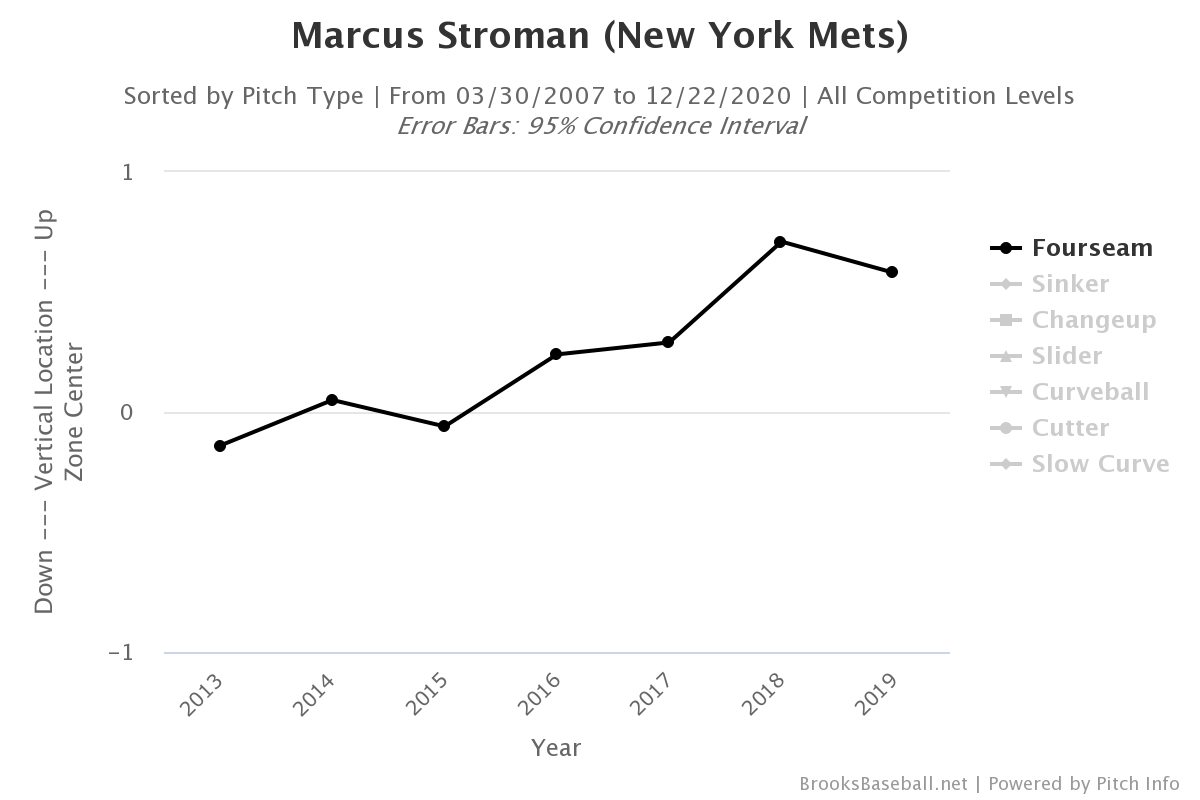If there’s a knock against Marcus Stroman, it’s that he pitches to contact an awful lot. He does it a lot better than most, but I suppose it’s a criticism nonetheless. There’s often a push and pull between limiting hard contact and getting whiffs, and Stroman has erred towards the former, mastering the art of being a heavy groundball pitcher while posting favorable outcomes. But he could be on the verge of making a few huge tweaks that elevate his game, too. Perhaps literally.
Consider this interaction between our own Alex Fast and Stroman:
New 4-seam and split-change coming soon too. The future excites me!
— Marcus Stroman (@STR0) December 22, 2020
Stroman is constantly trying to improve his game, so this is hardly surprising. He’s been openly looking for a changeup for years now, and although he thought he found it in 2019, it doesn’t appear that it was the pitch that he was looking for. It was the hardest change he’s even thrown, and it retained its depth, but the issue seemed to be that it didn’t separate from his sinker. The issues haven’t necessarily been with the various changeups themselves. It’s just that, because his sinker is so heavy, his changeup has a lot of difficulties separating itself.
That’s why I found the split-change exciting. Pitches of the splitter variety are notoriously difficult to command with consistency, but they’re an intriguing option for pitchers who can’t find a changeup grip that suits them. For Stroman, his changeup has struggled to separate from his sinker both in velocity gap and by vertical or horizontal movement. In fact, when not including the forces of gravity, his sinker actually gets more vertical movement than his changeup. Split-changes are low-spin pitches, and so, since Stroman hasn’t been able to kill lift on his changeup, his split-change may be able to help him get there. I was going to take the leap and make the assumption that Stroman gets himself there with the new split-change (perhaps via seam-shifted wake?). Then I saw the following tweet:
That’s the one.
— Marcus Stroman (@STR0) December 30, 2020
More information! But still not much to go on. We have a little video, but we can’t be certain how closely it resembles Robert Gsellman’s grip. Regardless, it was Gsellman-inspired, and so you’d think it should vaguely resemble his slow ball. If that ends up being true, then I don’t think that this is the pitch that he’s been seeking. But I’m also not convinced that that changeup (or split-change) is a pitch he’ll ever find.
I ran a query on Alex Chamberlain’s pitch leaderboard in which I filtered by starting pitchers and sorted sinkers by vertical movement. I only accepted pitchers who used their sinkers 30% or more since 2017, with velocity and movement that was in the proximity of Stroman’s. Here’s a list of those pitchers, and their changeup CSWs, since 2017:
- Marcus Stroman: 22.5% CSW
- Zack Godley: 22.1% CSW
- Mike Leake: 22.0% CSW
- Clayton Richard: 14.4% CSW
An incredibly, incredibly small sample of pitchers! That’s because very few pitchers throw a fastball as heavy as Stroman’s sinker. You’ll notice that these pitchers who do deploy a changeup a meaningful amount don’t have much success with them. Stroman actually leads the foursome since 2017, and yet even his 22.5% CSW on his changeup falls well short of league average since then, which is 25.9%. Given this, it seems unlikely that Stroman will ever be able to find the changeup that he’s looking for. Or so it seemed.
A video from August, featuring Stroman’s new split-change:
Well, look who it is…with a (new) Filthy Changeup…
— Rob Friedman (@PitchingNinja) August 8, 2020
Now, this split-change? That could be different. The camera angle isn’t great, but it looks to get a significant amount of fade, paired with plenty of drop. It got me thinking about an old Jeff Sullivan article in which he comps Stroman’s sinker to the late, great Roy Halladay. As far as sinkers go, both Stroman and Halladay throw good ones, and Stroman’s has actually been better by pVAL and pVAL/C. Now, Halladay was a good pitcher because he had a curveball and cutter to complement the sinker — Stroman has his slider. A changeup, though? Halladay didn’t have one. Let’s compare their sinker and changeup/split-change combinations against each other.
First, Stroman’s sinker and changeup in the past four years:

And then we have Halladay’s, in his last two years with the Blue Jays, and first two with the Phillies:

As I previously mentioned, Stroman’s sinker is so heavy that it gets more sink than his changeup if you don’t account for gravity. Halladay had the same issue. Then, when he went from the Blue Jays to the Phillies, he ditched the changeup and added a split-change. This turned out to be a wildly judicious change. He only threw his changeup 396 times during the pitch tracking area, but his split-change and changeup ended up being drastically different pitches.
- Changeup: 24.5% O-Swing%, 4.5% SwStr%, -5.7 pVAL, -1.4 pVAL/C
- Split-change: 44.4% O-Swing%, 20.6% SwStr%, 12.1 pVAL, 0.8 pVAL/C
This makes a lot of sense! Halladay had never been able to kill lift on his changeup, and so he switched it out for a pitch with a lot more drop. Now, saying that Stroman’s sinker’s strongest comp was Halladay’s sinker isn’t to say that they’re the same pitch—they aren’t. What feels fair to say, though, is that Halladay serves as a precedent for Stroman. If he’s adding something like Halladay’s split-change to his arsenal, I’m optimistic. I’ll withhold judgment until we see it come out to play, but I’m less hopeful if it more closely resembles his changeup of old. Although I’ll say that, in a vacuum, his new split-change is wicked.
Now, Stroman also said he’s got a new four-seam fastball in the works. I’m not sure exactly what that entails. What I can speak to is that he’s been increasingly using his four-seam fastball as an elevated pitch, and its spin rate has been increasing despite his velocity being down from prior years. If it were to take a step forward, it would not only benefit his other pitches but also gives him another potential whiff pitch that he doesn’t have outside of his slider. And so, while Stroman considers a changeup-type offering to be the pitch that he would add to his repertoire if he could, I think that a better four-seam fastball might be the pitch that would benefit his pitch ecosystem the most. In a way, though, they serve similar functions.
Consider his 2019 heat map, on the whole:

A lot of pitches are concentrated low and in the middle of the zone, which is fairly typical for a sinkerballer. He elevates his cutter sometimes to his glove-side, and his slider and changeup get thrown in the bottom of the zone at times, but overall, Stroman hasn’t vertically expanded his spread of pitches all that much.
Take a look at how his fastball has been tracking over the years, by short-form vertical movement:

Stroman hasn’t had this much fastball ride since 2016, nor has he had this much separation between his fastball and changeup since 2015. These past few years, he’s been using his fastball like never before, too, almost exclusively elevating it at or above the top of the zone (albeit with fairly minimal samples):

Given that his fastball has started to become more of a pitch that he can use upstairs, this is a taste of what we could see out of a Stroman four-seam fastball in 2021:
https://gfycat.com/artisticsinglehoneyeater
A four-seam fastball! In an 0-2 count! Against Mike Trout, no less! By pitch characteristics, his fastball has only gotten better since this point in time.
Then there’s his split-change. This is a changeup, but when Stroman unveils it this season, it’ll be thrown below the zone, as with this pitch:
https://gfycat.com/jealouscompletedutchshepherddog
That’s the bulk of it. With a revamped arsenal of pitches that includes an improved four-seam fastball and split-change, Stroman will hope to better differentiate between his pitches. The split-change, in theory, separates from the sinker, and his four-seam fastball will help to change the eye level of hitters at the top of the zone, which he could stand to do more. Expanding where he’s locating pitches in the zone vertically should make him even tougher to barrel up. More fastballs at the top of the zone and split-changes below the zone mean fewer pitches in the zone, which hopefully means fewer balls in play and more swinging strikes.
At the end of the day, it’s a trade-off. Fewer sinkers mean fewer ground balls, but it also should lead to more strikeouts. Stroman will probably always allow more balls in play than most, but right now, he will try and ease the burden that his sinker and slider are shouldering for his repertoire. As is, Stroman is a great pitcher, but if his fastball and split-change end up being the pitches he’s looking for he could be awfully dangerous—and that says nothing of the fact that Stroman has signed on with Codify over the offseason, gotten an upgrade behind the dish, and started working with a progressive pitching coach. Stroman has shown us several strengths, but he could be on the verge of folding in another.
Photo by Russell Lansford/Icon Sportswire | Adapted by Justin Paradis (@freshmeatcomm on Twitter)


Recently, I have read that the Mariners’ GM
Excellent sportswriting